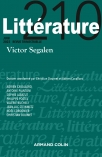
ROMANTISME N°205 (3/2024)
Pour acheter ce numéro, contactez-nous
Recevez les numéros de l'année en cours et accédez à l'intégralité des articles en ligne.
Pour interroger le rapport que la création entretient avec le visible chez Zola et comprendre ce rapport dans sa complexité, nous mettons la fenêtre, ouverture sur le monde, à l’épreuve du déploiement panoramique de ce monde. Les « fenêtres sur panorama » font droit aux ambivalences de deux dispositifs (fenêtres et panorama) pris entre distance et immersion, entre séparation et lien, entre le faire écran et le laisser voir. Notre analyse de trois romans – Une page d’amour, La Joie de vivre, La Terre – révèle trois modalités de l’interaction de ces deux dispositifs chez le romancier : la fenêtre qui risque de s’effacer à mesure que la vision panoramique la déborde ; la fenêtre qui fait écran lorsque le panorama se heurte à ses limites (par exemple face à l’invisible de la nuit) ; et, enfin, la fenêtre affirmée comme lieu de création d’un panorama fantasmé.
In order to examine the relationship between creation and the visible in Zola’s novels and to grasp the complexity of this relationship, we put the window, as an opening onto the world, to the test of the panoramic deployment of this world. “Windows on a panorama” are about the ambivalence of two devices (windows and panorama) caught between distance and immersion, between separation and connection, between “shielding” and “letting see”. Our analysis of three novels—Une page d’amour, La Joie de vivre, La Terre— reveals three ways in which these two devices interact in the novelist’s work: the window that may fade as the panoramic vision overflows it; the window that acts as a shield when the panorama collides with its limits (for example, when confronted with the invisibility of night); and, finally, the window that is affirmed as the site of the creation of a fantasised panorama.

